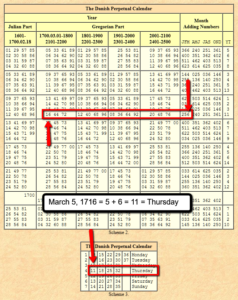 In 1995, Toke Nørby of Denmark uploaded The Perpetual Calendar to the r.c.p-h newsgroup and changed the lives of genealogists everywhere. While it was created for his own stamp collecting hobby, it is useful not only to genealogists or anyone tracking time across international calendars. Today, it sits on its own web page, The Perpetual Calendar, with historical information and instructions on how to use it.
In 1995, Toke Nørby of Denmark uploaded The Perpetual Calendar to the r.c.p-h newsgroup and changed the lives of genealogists everywhere. While it was created for his own stamp collecting hobby, it is useful not only to genealogists or anyone tracking time across international calendars. Today, it sits on its own web page, The Perpetual Calendar, with historical information and instructions on how to use it.
People studying material related to postal history often like to know on what weekday a dated or date postmarked letter (or any other item related to postal history) was cancelled. The need for this could be to find out what way a letter had been sent according to time and/or route tables for ships, trains or other mail carriers in regular service. In such cases this Perpetual Calendar, which covers the Julian and the Gregorian Calendar, can be a valuable tool as most of the postal history material we are concerned about originated from countries with Julian and/or Gregorian Calendars.
You know, of course, that in old days there were (and in some countries still are) other calendars (non-Julian and non-Gregorian) in use and my advice is: Do not collect postal history material from such countries! (I am just joking 😉
As far as I know you can find Perpetual Calendars published in different philatelic magazines. In 1985 I found that I did not quite understand on what calculations The Perpetual Calendar was based and I had some trouble finding out the right weekday for letters from Russia – but more about that later.
Another problem for me was that most of the Perpetual Calendars did not go as far back in time as I wanted, e.g. I had a Perpetual Calendar covering the years 1900-2200 and this was not satisfactory for me as most of my Danish inland ship letters are from the period 1836-1855. To solve this I sat down and worked out my own Perpetual Calendar.
Our modern calendar is based upon the Gregorian calendar created by Equinox Pope Gregorius XIII and astronomer Christoper Clavius in 1592. This calendar also established the 4 year leap year cycle that leaves those born on February 29 with fewer candles on their birthday cakes. Before the Gregorian calendar, Europe used the Julian Calendar named for Julius Caesar, not that he had much to do with it. It is believed to be developed by Dionysus Exiguus in 527 AD to count the years from the “birth of Jesus Christ” on December 25 753 AUC (Ab Urbe Condita or the founding of Rome), which also aligned with the vernal equinox.
Before the Julian Calendar, a calendars and time keeping was kept locally or regionally, as Toke explains in depth in his calendar studies and articles, including calendars from Israel, Germany, Hawaii, Lithuania, and more. And it hasn’t been a consistent calendar even since adoption of the Gregorian calendar.
As genealogists process documents across history to write the stories of our ancestors, we often forget that where they are dictates differences in how time was not just recorded but measured. An example in Toby’s article comes from trying to determine the date on Russian letters and postcards. He explains there was a difference of 11 days in the 18th century, and Russian Julian dates in the 1900s are 12 days before the Gregorian dates.
First rate postcard sent from Fyn (a Danish Island) to Dorpat, sometimes also called Derpt (Tartu) in Estonia. Postmarked on 24 July 1906 in the train leaving Assens bound for Tommerup (two Danish towns on Fyn). According to Scheme 2 and 3 the date 24 July 1906 was a Tuesday. As we can see the postcard was postmarked on arrival in Russia – at first sight ten days before it was sent from Denmark, namely on 14 July 1906 as shown in the Russian postmark! But at that time Russia used the Julian Calendar so to find the Gregorian date on arrival we can use the “rule of thumb” that after February 1900 the Julian Calendar was 13 days behind the Gregorian Calendar, so the Gregorian date of the Russian postmark is 14+13 = 27 July 1906.
Confusing, but if you are going for accuracy, it is worth the math.
Using the Perpetual Calendar takes some thinking, but once you get the knack, it is easy.
To determine the day of the week of an event, say March 5, 1716, on the Danish calendar:
Year + Month Adding Numbers = Day = Week Day Name
- On the Danish Perpetual Calendar in Scheme 2, find the year range of 1700-1800.
- Find the last two digits of the year for 16.
- Slide to the right to the column for Month Adding Numbers to find the number under the M for March. It is 6.
- Add 6 to 5, the day you are seeking, to total 11.
- In the chart for Scheme 3, find the number 11.
- To the right, find the day of the week for 11. It is Thursday, the day of the week for March 5, 1716 according to the Danish Calendar. If you were using the Gregorian Calendar, the event would be on a Monday.
You can confirm this with the easy-to-use calendar generator from Time and Date for March 1716 on the Denmark Calendar.
Each country and region listed has its own Perpetual Calendar charts, and all work about the same way. Reading through the tutorials and references is a wonderful step back through time and how it was tracked.
Most Recent Articles by Lorelle VanFossen
- The Myths and Mysteries and Hunt for Nicholas Knapp
- GenSmarts: Reminder to Not Assume
- Gensmarts Saves Your Family History Research Life
- Digging Through Historical Newspapers Online
- RootsMagic and Ancestry: Perfect Marriage





